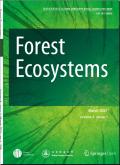原始森林与管理森林的生物多样性:老活树和大型死树的生物遗产驱动地衣多样性
IF 4.4
1区 农林科学
Q1 FORESTRY
引用次数: 0
摘要
人为活动在很大程度上造成了全球原始森林的丧失和破碎化,这加速了生物多样性的下降,特别是在依赖独特森林结构的高度特化物种中。然而,尽管原始森林和管理森林对有效监测和养护规划很重要,但它们之间的比较研究很少。为了解决这一知识差距,我们使用一个独特的数据集进行了一项比较研究,该数据集是在西喀尔巴阡山脉的一些保存最完好的混合山毛榉原始森林和邻近的管理对照林中建立的永久性研究地块。我们评估了森林结构和树木年龄对当代地衣群落的影响,这些影响是通过广泛的树木年代学重建确定的。原生林的地衣物种丰富度和红色名录物种丰富度分别比经管理的森林高26%和50%,突出了原生林的保护重要性。广义最小二乘(GLS)模型表明,在有管理的森林中,地衣物种丰富度与结构属性密切相关:随着最大树龄和直立枯木直径的增加,地衣物种丰富度增加,随着活树基底面积(BA)的增加而减少,这可能是由于林下光照减少。相比之下,没有结构变量显著解释原始森林的丰富度,可能是由于结构饱和度和广泛的微生境可用性。海拔是唯一具有显著解释力的变量。这些发现强调了结构复杂性在不同管理制度下支持地衣多样性的关键作用,并为促进老树、枯木(特别是大立木)和减少树冠密度等要素提供了有力的证据基础。与此同时,他们重申原始林作为生物多样性避难所的不可替代的价值,并强调需要制定景观一级的保护战略,将完整的原始林和结构丰富的管理森林结合起来。本文章由计算机程序翻译,如有差异,请以英文原文为准。
Biodiversity in primary vs. managed forests: Biological legacies of old living and large dead trees drive lichen diversity
Anthropogenic activities have significantly contributed to the loss and fragmentation of primary forests across the globe, which has accelerated biodiversity decline, particularly among highly specialised species dependent on unique forest structures. Nevertheless, comparative studies between primary and managed forests are scarce, despite their importance for effective monitoring and conservation planning. To address this knowledge gap, we conducted a comparative study using a unique dataset of permanent study plots established across some of the best-preserved, mixed-beech primary forests and their adjacent managed counterparts in the Western Carpathian Mountains. We assessed the effects of forest structure and tree age—determined through extensive dendrochronological reconstructions—on contemporary lichen communities. Lichen species richness and the richness of red-listed species were 26% and 50% higher in primary forests than in managed forests, respectively, highlighting the outstanding conservation importance of primary forests. Generalised least squares (GLS) modelling demonstrated that in managed forests, lichen species richness was strongly associated with structural attributes: It increased with maximum tree age and the diameter of standing deadwood, and decreased with higher basal area (BA) of living trees, likely due to reduced understory light. In contrast, no structural variables significantly explained richness in primary forests, likely due to structural saturation and widespread microhabitat availability. Elevation emerged as the sole variable with significant explanatory strength.
These findings underscore the critical role of structural complexity in supporting lichen diversity under different management regimes and provide a robust evidence base for promoting elements such as old trees, deadwood—especially large standing deadwood—and reduced canopy density. At the same time, they reaffirm the irreplaceable value of primary forests as biodiversity refuges and highlight the need for landscape-level conservation strategies that integrate both intact primary and structurally enriched managed forests.
求助全文
通过发布文献求助,成功后即可免费获取论文全文。
去求助
来源期刊

Forest Ecosystems
Environmental Science-Nature and Landscape Conservation
CiteScore
7.10
自引率
4.90%
发文量
1115
审稿时长
22 days
期刊介绍:
Forest Ecosystems is an open access, peer-reviewed journal publishing scientific communications from any discipline that can provide interesting contributions about the structure and dynamics of "natural" and "domesticated" forest ecosystems, and their services to people. The journal welcomes innovative science as well as application oriented work that will enhance understanding of woody plant communities. Very specific studies are welcome if they are part of a thematic series that provides some holistic perspective that is of general interest.
 求助内容:
求助内容: 应助结果提醒方式:
应助结果提醒方式:


